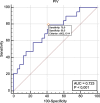Can the pan-immune-inflammation value predict gram negative bloodstream infection-related 30-day mortality in solid organ transplant patients?
- PMID: 38789916
- PMCID: PMC11127423
- DOI: 10.1186/s12879-024-09413-x
Can the pan-immune-inflammation value predict gram negative bloodstream infection-related 30-day mortality in solid organ transplant patients?
Abstract
Background: The recently used pan-immune-inflammation value (PIV) has not been adequately studied as a predictive marker for mortality in immunosuppressed patients. The aim of this study was to evaluate the usefulness of baseline PIV level as a predictor of 30-day mortality in solid organ transplant (SOT) recipients with gram negative bloodstream infections (GN-BSI).
Methods: This retrospective, cross-sectional study was conducted between January 1, 2019, and December 31, 2022, in 1104 SOT recipients. During the study period, 118 GN-BSI were recorded in 113 patients. Clinical, epidemiological, and laboratory data were collected, and mortality rates (30-day and all-cause) were recorded.
Results: The 113 recipients had a median age of 50 years [interquartile range (IQR) 37.5-61.5 years] with a male predominance (n = 72, 63.7%). The three most common microorganisms were as follows: 46 isolates (38.9%) of Escherichia coli, 41 (34.7%) of Klebsiella pneumoniae, and 12 (10.2%) of Acinetobacter baumannii. In 44.9% and 35.6% of the isolates, production of extended-spectrum beta-lactamases and carbapenem resistance were detected, respectively. The incidence of carbapenem-resistant GN-BSI was higher in liver recipients than in renal recipients (n = 27, 69.2% vs n = 13, 17.6%, p < 0.001). All-cause and 30-day mortality rates after GN-BSI were 26.5% (n = 30), and 16.8% (n = 19), respectively. In the group with GN-BSI-related 30-day mortality, the median PIV level was significantly lower (327.3, IQR 64.8-795.4 vs. 1049.6, IQR 338.6-2177.1; p = 0.002). The binary logistic regression analysis identified low PIV level [hazard ratio (HR) = 0.93, 95% confidence interval (CI) 0.86-0.99; p = 0.04], and increased age (HR = 1.05, 95% CI 1.01-1.09; p = 0.002) as factors associated with 30-day mortality. The receiver operating characteristic analysis revealed that PIV could determine the GN-BSI-related 30-day mortality with area under curve (AUC): 0.723, 95% CI 0.597-0.848, p = 0.0005.
Conclusions: PIV is a simple and inexpensive biomarker that can be used to estimate mortality in immunosuppressed patients, but the results need to be interpreted carefully.
Keywords: Gram negative bacterial infection; Mortality; Multidrug resistance; Pan-immune-inflammation value; Solid organ transplantation.
© 2024. The Author(s).
Conflict of interest statement
The authors declare no competing interests.
Figures
References
-
- Carlberg C, Velleuer E, Molnár F. Innate Immunity and Inflammation. In: Carlberg C, Velleuer E, Molnár F, editors. Molecular Medicine: How Science Works. Cham: Springer International Publishing; 2023. pp. 229–252.
MeSH terms
LinkOut - more resources
Full Text Sources


